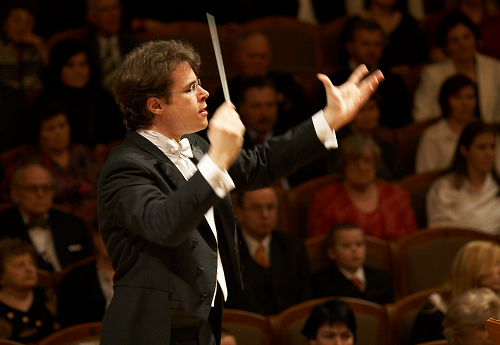 United Kingdom Mahler: Camilla Tilling (soprano), Jennifer Johnston (mezzo-soprano), Philharmonia Chorus and Orchestra / Jakub Hrůša (conductor). Royal Festival Hall, London, 20.2.2020. (CC)
United Kingdom Mahler: Camilla Tilling (soprano), Jennifer Johnston (mezzo-soprano), Philharmonia Chorus and Orchestra / Jakub Hrůša (conductor). Royal Festival Hall, London, 20.2.2020. (CC)

Mahler – Symphony No. 2 in C minor, ‘Resurrection’
Czech conductor Jakub Hrůša’s star is very much in the ascendant. Currently Chief Conductor of the Bamberg Symphony and Principal Guest Conductor of both the Philharmonia and the Czech Philharmonic, his readings have always been characterized by musical intelligence, innate musicality and an ability to inspire. Previously, he has introduced London audiences to the music of Jan Kabeláč, as well as reminding them of the stature of Suk (review). Most relevantly to the present concert, there was a Mahler Third Symphony in February 2016, which I reviewed.
This Mahler 2 seemed to imply his readings are becoming ever deeper, and left quite an impression. Mahler’s scores are such that we all think we know them, yet they leave space for someone to come along and unearth layers of detail that can seem utterly revelatory. Such was the case with Hrůša’s account of the Second. Right from the start, this was destined to be one of the most involving and stimulating. The way Hrůša held the tension between the first statement of the cello and double-bass semiquavers and the second, the latter an incredibly clean ascent, declared an interpretative and orchestral standard that was to persist throughout. Here is a conductor who would not be hurried, who knows that the honouring of structural tensions determines the greatness of a reading. He was not afraid to bring a sense of Schwung to phrases, and yet also inspired the Philharmonia strings to moments of great tenderness. Listening to oboe and bassoon against a string tapestry, one became aware of just how momentously great is Mahler’s orchestration. In the spirit of this huge orchestra in collaboration to bring forth Mahler’s behemoth symphony, it was interesting to note that the leader’s solos, beautifully delivered by Zsolt-Tihamér Visontay, were very much first among equals (the compatriots being the ever-responsive woodwind).
On the structural level, Hrůša’s way with accelerandi made perfect sense; his Luftpausen were as disciplined as any Salonen, that paragon of stick technique, could create. Brass climaxes were huge, confirming the stellar nature of that section of this orchestra. And how dead was the pizzicato at the close of the enormous first movement. In a very different context in the next movement, an Andante moderato, the quietest pizzicato could be heard (if they had dropped a pin, we would have heard that, too); yet the incendiary nature of Mahler’s processes meant that the music could explode like a volcano, streams of sonic lava flowing in its wake. Hrůša made us wait for the last pizzicato of that movement, too. How shadowy, yet supremely together, was the scherzo, a nightmarish tap-tap from percussion disturbing on a soul level. And how lightly the double-basses could scamper; again, with a superb sense of togetherness. How rare to hear spirit and technical perfection hand-in-hand.
And so, with a surtitled ‘Urlicht,’ the true journey to hell and back began. Jennifer Johnston, a former BBC New Generation Artist, delivered the text mesmerically, the answering, restrained brass chorales perfectly controlled and balanced. A real, genuine Ur-schrei from the orchestra dismissed the fourth movement. Off-stage brass (played from the hall’s level three spaces) were perfectly placed; a fine top C (sounding F) from the horns too, perfectly in tune and yet one could hear it was several (four) horns on the same note. From Hrůša, a Bruno Walter-like relishing of the triplet crotchet-quaver motif added weight to the ongoing tragedy. The famous percussion crescendo was superbly controlled, if not hair-raising. It was, instead, part of a longer trajectory, one that juxtaposed Zemlinsky-like fairytale (never have the parallels been so clear) with the blackest empty spaces and the brightest radiance. And while we’re on the subject of parallels with other composers, rarely has the kinship of Mahler and Charles Ives been so clear; one could hear proto-Ivesian layering techniques impeccably clearly.
The chorus was as fine as the orchestra, the almost inaudible entrance stopping time, and Camilla Tilling’s radiant soprano emerging naturally from the texture like the rising of a morning star. Good for Hrůša to give the clarion choral call of ‘Bereite dich’ (‘Prepare yourself’) space, an expansive gesture that led to a simply glowing ‘Aufsteh’n’ (‘Rise again’). Intriguingly, the post-choral coda held a little sag in energy, but hardly enough to register in the overall scale of the majesty of this performance. Hrůša is still young; one wonders what more he can bring … more Mahler, for sure, and, one hopes, yet more revelations from his homeland.
Colin Clarke